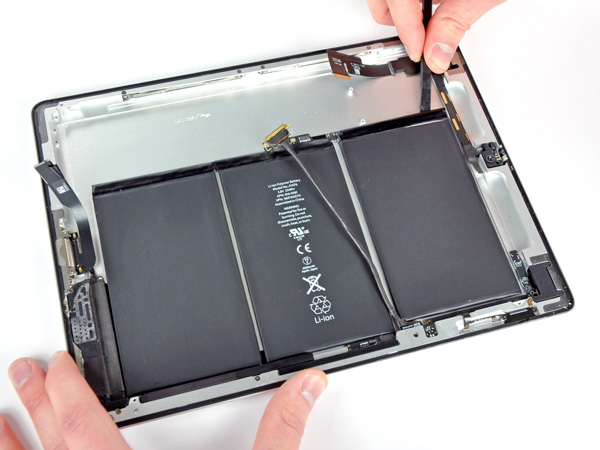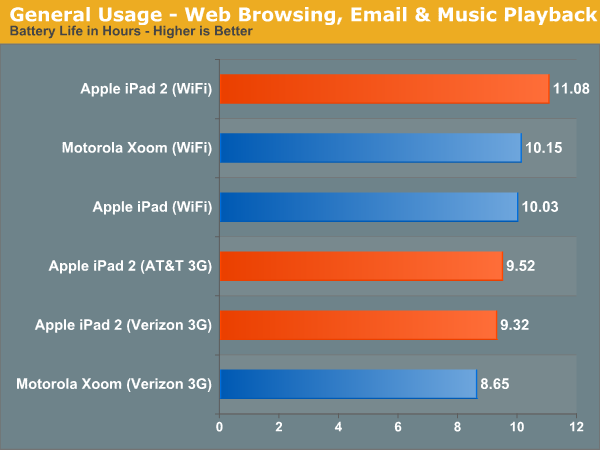The Apple iPad 2 Review
by Brian Klug, Anand Lal Shimpi & Vivek Gowri on March 19, 2011 8:01 PM ESTBattery Life
Testing battery life on a tablet is pretty grueling as these things are effectively smartphones with gigantic batteries. What would last for only a few hours on a smartphone can easily last over ten on a tablet. The iPad 2 is no exception.
As iFixit discovered, the iPad 2 features a nearly identical battery to the original iPad (25Wh vs. 24.8Wh). We already established that display brightness hasn't gone up so the only real impact on battery life will be because of the A5 SoC.

The iPad 2 WiFi's battery, courtesy iFixit
The ARM Cortex A9 tends to be more power efficient than its predecessor, the A8. With a shallower pipeline and the ability to execute instructions out of program order you get better performance per watt in most cases. As a result the A5 should complete bursts of instructions quicker than the A4 and get back to sleep sooner.
To put this to the test we put together a battery life test that combined our non-Flash smartphone web browsing test, checking for email every 15 minutes (via a Gmail account receiving ~100 emails per day) and constant local music playback while all of this is going on. The results are pretty much as expected:

Over WiFi the Motorola Xoom and iPad 1 deliver very similar results. The iPad 2 pulls ahead by around 8%, it's not a huge advantage but it's there. Over 3G there's a noticeable drop in battery life, putting both of the iPad 2s below 10 hours and kicking the Xoom down to under 9 hours. All of the numbers on this chart are respectable however and you can expect a good day's worth of use out of any of these tablets.
Note that while the iPad 2 did better than its predecessor if you were to run an app that pegged both CPU cores at 100% you'd see reduced battery life on the iPad 2 vs. the iPad 1. Granted you'd also see better performance on the iPad 2.
Video playback is obviously an important function of these new tablets so we put together a H.264 decode playback test as well. For this test we transcoded a copy of Quantum of Solace from a 1080p BD source down to a 720p H.264 using Handbrake's Normal encode profile with one modification. In order to enable smooth playback on the Motorola Xoom we had to disable b-frames in the encode. The results are below:

The iPad 2 consistently lasted longer than the original iPad in our video playback test. The Xoom however did noticeably worse. Unfortunately only a portion of the H.264 decode pipeline is accelerated by NVIDIA's Tegra 2 in this test. When playing back anything more strenuous, portions of the pipeline are handled by the CPU cores in software. If you were to enable b-frames the Xoom would not only stutter but its battery life would drop to around 6 hours.
On the iPad 2 its Cortex A9s are mostly powered down during this test, on the Xoom the A9s are helping with the heavy lifting for video decode and as a result we see lower battery life. Kal-El is expected to address this issue head on.










189 Comments
View All Comments
Azethoth - Monday, March 21, 2011 - link
No! 22 seconds is not fast enough. That is 20 seconds wasted each time you do that in a day.benonemusic - Monday, March 21, 2011 - link
Excellent writing and content as usual. As a longtime reader (this is my first post) with an editorial eye, I had a suggestion for future articles such as this with multiple authors but in which the main review is written in the first person singular. It was slightly disorienting to see three authors (Brian, Anand, Vivek) but then much of the article written with "I" (presumably Anand), you might want to avoid listing all three authors as "ands" in that case. One idea would be make the first author the one who is speaking in the first person voice (presumably Anand in the case) and the other two to be listed as "with." If the review is written as "we" then having all three of the authors as "ands" makes sense. There are multiple solutions. You can simply keep the "ands" and then indicate who the "I" is in the first instance. You could obviously say "one of us" in the first instance and indicate "Anand" in parentheses. And so on. Sorry for going on this long, but I'm big on bylines. Keep up the great work with the articles!embeddedGPU - Monday, March 21, 2011 - link
Can you clarify the floating point precision for your GPU GFLOPS figures ? You mention 20-/32-bit for nVidia, but I think the SGX is only 16-bit precision. If so, it's not a totally fair comparison...wellortech - Monday, March 21, 2011 - link
"If you fell in love with the original iPad, the iPad 2 is a significant upgrade."Really? Since when is thinner and a crappy camera a significant upgrade?
mcnabney - Monday, March 21, 2011 - link
You guys missed noticing something when documenting the huge step forward with the iPad2 GPU power.We now have iOS fragmentation.
The entire iPad1 generation was obsoleted in the graphics department. Now developers have to choose between writing for the iPad1 or iPad2. There is far too large of a gulf between the two platforms. To benefit from the GPU advancement, the massive installed base of the iPad1 will have to be written-off.
kmmatney - Monday, March 21, 2011 - link
I don't think this is true. First, we are only talking about 2 models, and second, they can just enable more graphics features for iPad 2. I can see where some truly advanced games might only be written for the iPad 2 in the future, but there is really no way to avoid that.Azethoth - Monday, March 21, 2011 - link
There always was and always will be iOS fragmentation since the 2nd iDevice shipped.As for what it means in a practical sense: check out Infinity Blade on multiple devices (iPhone and iPad). See, not a big deal, content providers are used to scaling artwork and design.
Furthermore, iOS will suffer less from this than Android (fewer device specs). It is one of the aspects of the competition at this form factor that makes me think that Apple will do better than it does at the PC level. (Not that Apple PC profits are not insanely good for their industry: over 50% of entire industry by some accounting).
araczynski - Monday, March 21, 2011 - link
if you're after a notebook/pc replacement, you're kidding yourself with any tablet.if you're after a gaming device, you're golden :) especially if you think gaming on phone sized screens (this includes psp/ds/etc) is plain stupid.
mine is filled to the brim with games, no room for audio/video/etc, just pure games.
i love it, my daughter loves it, even my technophobe wife loves it.
its for entertainment, nothing more.
Azethoth - Monday, March 21, 2011 - link
It is for more than entertainment:You can amuse your cat with it as well!
coolio68 - Monday, March 21, 2011 - link
Great review Anand,regarding this comment though:'The real competition for the SGX 543MP2 will be NVIDIA's Kal-El. That part is expected to ship on time and will feature a boost in core count: from 8 to 12. The ratio of pixel to vertex shader cores is not known at this point but I'm guessing it won't be balanced anymore. NVIDIA is promising 3x the GPU performance out of Kal-El so I suspect that we'll see an increase in throughput per core.'
Worth bearing in mind a couple of things:
SGX 543MP can already incorporate 2 to 16 cores
The even higher performance SGX 554MP cores have also been announced in December
Power VR Series 6 (Rogue), the next-generation, can scale from 210 GFLOPS to 8 TFLOPS , and is already licensed by the usual suspects.
The A9600 chip announced by ST-E at MWC ,containing Rogue, is sampling in H2 2011.
Nvidia are gonna have their work cut out methinks, but the competition is great for the industry and consumers.